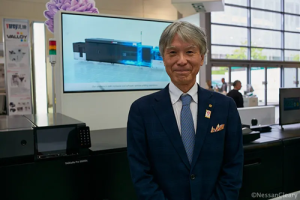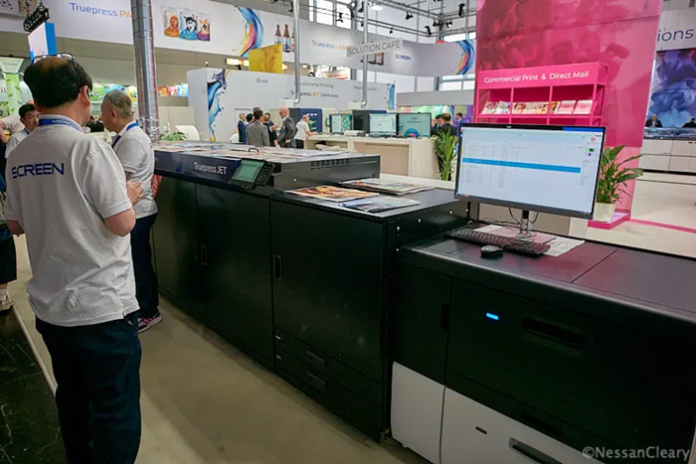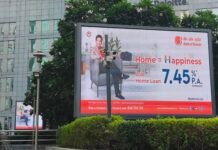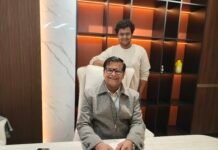Kyocera Document Solutions demonstrated its latest inkjet printer, the TaskAlfa 55000c, which was first shown at the Printing United show in the US last year but made its European debut at drupa, though I first came across it at IGAS 2022.
The new press is essentially an evolution of the existing single-pass inkjet TaskAlfa 15000c and is part of Kyocera’s stated aim to expand from its core office print market into production printing.
The company has come a long way since it first started looking into inkjet technology 20 years ago. Hironori Ando, president of Kyocera Document Solutions, says that those first discussions led directly to building the presses shown at Drupa, noting, “We started in 2011 and completed our first prototype in 2016. In 2019, we launched the TaskAlfa 15000c and have made improvements since then. Our desire to meet customer needs has led to the latest machine, the TaskAlfa 55000c, which supports printing to coated paper.”
The 15000c has proven to be very successful with over 600 installations worldwide. It’s a small, inexpensive press that’s as easy to operate as a standard office printer but is aimed at production printing. However, for best results, it is limited to inkjet-coated stocks, which pushes up the running costs. For this reason, it’s mostly been used for transactional work, and, consequently, Kyocera has refocused and now primarily promotes it for transactional printing.

Nonetheless, the 15000c clearly demonstrated that there was a demand for a similar printer that could accommodate a wider range of media to enable customers to take on more lucrative applications.
So Kyocera arrived at an arrangement with Screen to adapt the SC ink that Screen had developed for its TruePress Jet 520 presses for use with the TaskAlfa. Shinichi Uchida, general manager of the R&D division, explains that the inkjet cut sheet market is very busy right now, noting: “To develop our product as soon as possible we thought it best to use the Screen ink.”
Handily, Screen also switched from using Ricoh to Kyocera printheads for its latest model so formulating the ink for use in the Task Alfa was relatively easy though Screen has renamed it as SF ink. This arrangement also means that Screen sells the same press as the TruePress Jet S320 though both versions are manufactured by Kyocera.
Screen originally developed the SC ink to help it move its larger Truepress Jet series of inkjet presses from transactional to commercial printing by working with standard offset-coated papers. Consequently, there’s no pretreatment needed and the printer will handle both coated and uncoated papers, which makes it a relatively unique machine in this class. It’s primarily aimed at high-quality applications such as books and magazines. Screen claims that the ink has a wider color gamut than is typical for offset printing, and certainly, the samples that both vendors showed at Drupa were quite good considering that this press should be considerably cheaper than other production inkjet presses.
Naturally, the 55000c uses Kyocera printheads, the KJ4B EX 1200, and prints at 1200 x 1200 dpi resolution. There are three heads per color, and four colors in total – CMYK – so 12 heads altogether.
The new 55000c runs at the same speed as the existing 15000c of 150 A4 simplex ppm. It takes sheets up to SRA3 size, with a maximum print width of 326.1mm. There’s an optional multi-purpose tray that can take banners up to 1220 mm. It can handle media from 50 to 400 gsm. The standard configuration will hold 6100 sheets but there’s a good choice of different paper drawers so that it can hold up to 11,810 sheets.
The press has a Fiery controller. Kyocera is offering customers a choice between its own GC9100 front end or a Fiery 51 DFE. Screen is only using the Fiery DFE but its version can be connected to its Equios production workflow system, so that files can be sent from Equios to the Fiery front end, and back to the workflow if there are any problems. This, in turn, means that Screen customers can operate the S320 alongside their larger inkjet presses, freeing those presses up for a longer run or more valuable jobs.
The 55000c has a small footprint of just 8.5m long by 1m wide. Uchida says, “Our main unique point is the compact size while other competitors are bigger. We are very good at using small footprint products but that’s not our only market.”
Kyocera itself operates like a collection of different companies rather than a fully integrated group. Ando argues that this separation helps to reassure Kyocera’s printhead customers that they are not facing unfair competition from Kyocera’s own printer manufacturing activities, noting, “So the printhead division is a different company and they treat us as a customer. But they also handle our requirements as a customer demand.”
Ando says that this separation between the different parts of Kyocera is because the company’s roots lie in the ceramic industry and it has grown by acquiring other companies, adding, “But we share the same philosophy and that unites us.” That philosophy is to produce products that in some way benefit the environment. He continues: “For commercial and textile, the concept is to print on demand only what is necessary. In doing so we can contribute to the environmental issues.”
Uchida expands on this, saying, “The company philosophy is to use water-based pigment ink and Kyocera heads.” He says that the main focus is around environmentally friendly products that are small enough to go anywhere and have a low TCO, adding: “We can reduce the transport costs through the supply chain by digitalization and helping customers to only produce what they need.”
He continues, “We want to apply our technology to various models and markets, for example, printing directly to bottles without labels. It’s difficult but there’s a big opportunity.”
Uchida also gave me an update on the Forearth textile printer. This is almost ready for its commercial launch with Kyocera planning a gradual rollout, starting in Japan, then Europe later this year, followed by worldwide availability. Kyocera is also thinking about the direction to go in next. Uchida says that today the printer can produce 250 sqm per hour, adding: “But we are thinking about much higher productivity.” He is also considering if there is a demand for a smaller, cheaper model.
In the meantime, the TaskAlfa 55000c is already available to order in Japan with the first customer installation due shortly, besides the two that are already installed at beta sites. You can find more details about the TaskAlfa production printers from kyoceradocumentsolutions.eu.

















